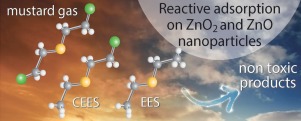Applied Catalysis B: Environment and Energy ( IF 20.2 ) Pub Date : 2017-12-28 , DOI: 10.1016/j.apcatb.2017.12.068 Dimitrios A. Giannakoudakis , Marc Florent , Rajiv Wallace , Jeff Secor , Christopher Karwacki , Teresa J. Bandosz

|
Highly porous zinc peroxide nanoparticles were synthesized at ambient conditions following a one-pot wet precipitation method. Subsamples were calcined at various temperatures up to 400 °C. The structural, morphological, optical and chemical features were evaluated by X-Ray diffraction, N2 adsorption, scanning electron microscopy, diffuse reflectance UV–vis spectroscopy, Raman spectroscopy, and thermal analysis. The degree of ZnO2 decomposition to ZnO was monitored by XRD or Raman spectroscopy. The content of peroxide and the ability to form hydroxyl and super oxide radicals were also evaluated. The affinity of the synthesized samples to reactively adsorb chemical warfare agent surrogate of mustard gas, 2-chloroethyl ethyl sulfide (CEES) or ethyl ethyl sulfide (EES) was evaluated. Zinc peroxide nanoparticles were found as the best performing material, due to a high porosity and favorable surface chemistry. Moreover, they showed the ability to selectively oxidize EES to ethyl ethyl sulfoxide. In the case of CEES adsorption and subsequent reaction, the major surface reaction product was hydroxyethyl ethylsulfide (HEES). This suggests that the formation of a transient intermediate sulfonium cation is the predominant detoxification pathway. Weakly adsorbed and/or structural water enhanced the vapor retention and the decomposition performance. The ultimate task was to evaluate the detoxification performance against the real mustard gas. Zinc peroxide nanoparticles showed a marked detoxification activity with a conversion rate of 67.5%.
中文翻译:

过氧化锌纳米粒子:表面,化学和光学性质以及热处理对芥子气解毒的影响
一锅湿式沉淀法在环境条件下合成了高度多孔的过氧化锌纳米粒子。将子样品在高达400°C的各种温度下煅烧。通过X射线衍射,N 2吸附,扫描电子显微镜,漫反射紫外可见光谱,拉曼光谱和热分析对结构,形态,光学和化学特征进行了评估。ZnO 2的程度通过XRD或拉曼光谱监测分解为ZnO。还评估了过氧化物的含量以及形成羟基和超氧化物自由基的能力。评价了合成样品对芥子气,2-氯乙基乙基硫化物(CEES)或乙基乙基硫化物(EES)反应性吸附化学战剂替代物的亲和力。由于高孔隙率和良好的表面化学性质,发现过氧化锌纳米颗粒是性能最好的材料。而且,它们显示出将EES选择性氧化为乙基乙基亚砜的能力。在CEES吸附和随后反应的情况下,主要的表面反应产物是羟乙基乙基硫化物(HEES)。这表明暂时的中间体sulf阳离子的形成是主要的排毒途径。弱吸附和/或结构化的水增强了蒸气保留性和分解性能。最终任务是针对真正的芥末气评估排毒性能。过氧化锌纳米颗粒显示出明显的解毒活性,转化率为67.5%。











































 京公网安备 11010802027423号
京公网安备 11010802027423号